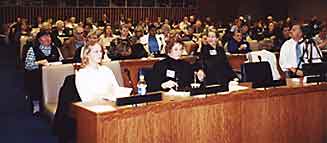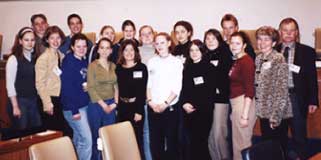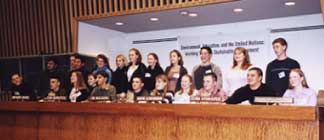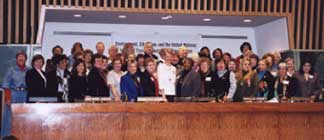2002
2002 CTAUN Conference
Friday, January 11, 2002
Environment, Education and the United Nations Working Towards Sustainable Development
Opening Address
Anne-Marie Carlson
Conference Chair
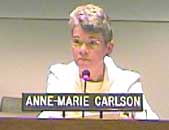 Mrs. Carlson welcomed participants to the conference, the fourth in an annual series, organized by the Committee on Teaching About the United Nations (CTAUN) in association with the United Nations Department of Public Information (UN/DPI).
Mrs. Carlson welcomed participants to the conference, the fourth in an annual series, organized by the Committee on Teaching About the United Nations (CTAUN) in association with the United Nations Department of Public Information (UN/DPI).
She reported that 334 had registered, representing 6 countries. In addition to the U.S.A. with 15 states plus the District of Columbia, they were Canada (Ontario and Quebec), Denmark, Russia, and Cameroon. The registrants represented all levels of education from early childhood to university levels and both public and private/independent schools. There were also a number of environmental studies students from schools in Rastede, Germany; Newtown, PA; and Pearl River, NY.
An environmental information fair scheduled for early afternoon had exhibits and materials of interest for educators from 19 environmental groups. There was also a major display of environmental books at the U.N. Bookstore.
Introduction
Environmental Issues and the United Nations
Nitin Desai
United Nations Under-Secretary-General, Department of Economic and Social Affairs (DESA)
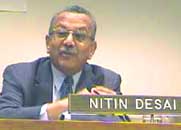 Noting that the environment issues know no boundaries, Mr. Desai stressed a need for global cooperation. Global issues, such as climate change, the ozone layer, and the protection of endangered species all require a global approach.
Noting that the environment issues know no boundaries, Mr. Desai stressed a need for global cooperation. Global issues, such as climate change, the ozone layer, and the protection of endangered species all require a global approach.
The United Nations operates on several levels. Its environmental monitoring and assessment brings together scientists on various issues and builds scientific consensus on the nature of the problems. This eventually leads to treaties to enforce action like the Kyoto Protocol on Climate Change.
By developing and acknowledging the shared values of our common humanity (e.g. Declaration of Human Rights) the UN also builds environmental awareness, reminding people of their environmental responsibilities.
Sustainable Development is the “step beyond.” Environment must be looked at in combination with and take into consideration the totality of human needs. For example, in India reforestation is not just an issue of vegetation, but must also involve alternative energy and building materials, agricultural land use, and planning.
The upcoming Johannesburg Summit will continue these processes. Information can be found on the web: http://www.johannesburgsummit.org.
Morning Panel
Climate Change and Energy
Elliot Diringer
Director, International Strategies, Pew Center on Global Climate Change, Arlington, VA
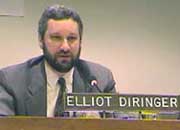 Mr. Diringer said that since the Rio Conference on Environment and Development in 1992, there had been a much greater focus on environmental issues, but there was still a long way to go. Improving the situation would only be possible if there was a new spirit of cooperation between nations.
Mr. Diringer said that since the Rio Conference on Environment and Development in 1992, there had been a much greater focus on environmental issues, but there was still a long way to go. Improving the situation would only be possible if there was a new spirit of cooperation between nations.
Mr. Diringer listed four main features of the problem:
- Climate change is essentially a global phenomenon. Green house gases affect us all and all of us were involved in producing them — from the taxi driver in New York to the power plant in New Delhi. The best hope of controlling emissions lay with the Kyoto Protocol and all nations, including the US, should sign up to it soon.
- Climate change is essentially a long-term challenge. The 1990s were the hottest decade of the millennium; the ice cap grew thinner and spring came earlier. The world has to move away from fossil fuels. Politicians and businessmen who tended to think only short-term had to be persuaded that the pay-off for long-term thinking would be crucial for a viable future for the whole planet.
- There is uncertainty in predicting the future. Estimations of global warming in the next century vary from 2% to 10%. Sudden changes could have a catastrophic effect. The sooner governments and businesses took action, the less costly would be the effects of climate change.
- There is a deep unfairness about the likely effects of global warming. In the past, one-third of all global warming was caused by the developed countries, but in the future developing countries will give off far more harmful gases. Because of the high costs involved, it is difficult now to get developing countries to take precautionary action. In the future, the poorest countries would suffer the most from severe climate change – places such as Bangladesh, small island states such as Tuvalu, and African States bordering on desert areas. Fairness in sharing the burdens of prevention would be essential.
The whole problem requires a response which would be creative, resourceful and understanding, and all members of civil society should join in overcoming this new challenge.
Environmental Degradation
Adnan Z. Amin
Director, New York Office, United Nations Environmental Programme (UNEP)
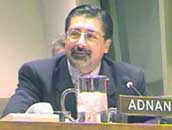 Mr. Amin reminded the audience that nature is not only beautiful to the senses, but also crucial to economic and social needs. No problem in the world can be approached in isolation; it is all interconnected — science and philosophy combined; geography, history, politics, and economics.
Mr. Amin reminded the audience that nature is not only beautiful to the senses, but also crucial to economic and social needs. No problem in the world can be approached in isolation; it is all interconnected — science and philosophy combined; geography, history, politics, and economics.
UNEP‘s mandate is to be the leading environmental agency. This is possible only through education and awareness, especially of youth. The fourth “R” (reading, ‘riting, ‘rithmetic) is “respect for the environment.” Education about the environment is a lifelong learning process, and for over 30 years the U.N. has made vital contributions to understanding greenhouse gasses and environmental degradation.
Sustainable development is also a primary U.N. concern. People must be put first; development must take into account the “whole picture.” There must be a united front against poverty AND environmental degradation. It is impossible to underestimate the importance of environmental change and the need to reconcile differences in dealing with it. Environmental degradation is the direct result of the unsustainable use of the world’s resources. The poor suffer the greatest impact from environmental degradation, from the lack of clean water to the loss of farm land to desertification.
The end of the Cold War has greatly relieved the threat of world war, but the threat of environmental degradation looms equally as large, if not larger.
Student Presenters and Teachers
Pesticides
Jean-Dominic Levesque-Rene
Recipient, 2001 United Nations Environmental Award, Ile Bizard, Quebec, Canada
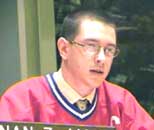 Jean-Dominic, proudly wearing the red and white jersey of the Montreal ice hockey team, spoke about his long struggle as a young person to get local and national governments to ban harmful pesticides. He himself contracted cancer at age ten and underwent a long course of chemotherapy. While in the hospital, he discovered that other young people from his home town also had cancer. He suspected the cause was the herbicide used on the many local golf courses.
Jean-Dominic, proudly wearing the red and white jersey of the Montreal ice hockey team, spoke about his long struggle as a young person to get local and national governments to ban harmful pesticides. He himself contracted cancer at age ten and underwent a long course of chemotherapy. While in the hospital, he discovered that other young people from his home town also had cancer. He suspected the cause was the herbicide used on the many local golf courses.
Initially the mayor and the local city council saw no proof of his allegation. But after eight years of campaigning across Canada by Jean-Dominic and his friends, they finally won the battle to get a total ban on harmful pesticide use on golf courses. He said his career had made him like a soldier, and he summed up his dedication to the cause of creating a safe environment for all in the words of Rachel Carson: “The more clearly we can focus our attention on the wonders and realities of the universe about us, the less taste we shall have for destruction.”
Environmental Learning Labs
Mehrosh Khan
Student, Curtis High School, Staten Island, NY and Ms. Virginia Guido, Science Coordinator, District 31, Staten Island, NY
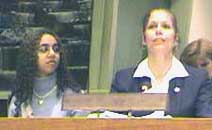 Mehrosh Khan and Virginia Guido
Mehrosh Khan and Virginia Guido
Ms. Guido reviewed the evolution of a “Garden of Dreams” from a vacant lot abutting an elementary school. Students, parents and community groups helped rid the lot of debris and, over a period of time, the students planned the garden as a part of the school’s science/environmental curriculum. Respect for life was the overriding theme and academic skills were integrated into all aspects of the project.
Mehrosh Khan (now in high school) was one of the students involved in the garden project throughout her elementary school years. She described the research to identify plants indigenous to the area, the relationships between plants and soil, natural pesticides used, bird houses and feeders erected, and the work on graphing, observing and identifying insect and animal life. Monthly journals were kept and evaluated and students had responsibility for the care and progress of the “Garden of Dreams.’
Global Learning and Observation to Benefit the Environment (GLOBE) — Kahja Reid, Student, and Ms. Christine McGurrin, Teacher, Rensselaer Park Elementary School, Troy, NY
Christine McGurrin and Kahja Reid
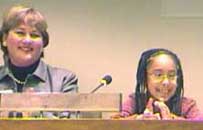 GLOBE is a “hands on,” school-based program used both nationally and internationally. There are 16,000 GLOBE teachers internationally. The aim is to “Preserve the past, Respect the present, Preserve the future.” Ms. McGurrin described the program, how it can be integrated into school curricula and used to strengthen academic skills and teach environmental values. Its website ishttp://www.globe.gov.
GLOBE is a “hands on,” school-based program used both nationally and internationally. There are 16,000 GLOBE teachers internationally. The aim is to “Preserve the past, Respect the present, Preserve the future.” Ms. McGurrin described the program, how it can be integrated into school curricula and used to strengthen academic skills and teach environmental values. Its website ishttp://www.globe.gov.
Kahja Reid, a confident and delightful third grader, described the activities of her class as it constructed and monitored a weather station.
Afternoon Sessions
Population, Poverty, and Sustainable Development
Stan Bernstein
Senior Research Adviser, United Nations Population Fund (UNFPA)
 Mr. Bernstein began by defining sustainable development as a process that “meets the needs of the present without compromising the ability of future generations to meet their needs.” It is an inter-generational approach based on insuring a decent quality of life for all the world’s people. Population today is 6.2 billion, an increase of 3 billion since 1960. It is projected to be 9.3 billion by 2050.
Mr. Bernstein began by defining sustainable development as a process that “meets the needs of the present without compromising the ability of future generations to meet their needs.” It is an inter-generational approach based on insuring a decent quality of life for all the world’s people. Population today is 6.2 billion, an increase of 3 billion since 1960. It is projected to be 9.3 billion by 2050.
Even though the rate of growth has slowed as a result of women spacing the birth of their children, the need to feed the growing numbers will put an increasing strain on the environment. For example, the Green Revolution required the use of massive amounts of fertilizers and pesticides and led to the depletion of the soil. Irrigation schemes have led to the drying up of the Aral Sea and the reduction of the water level on Lake Chad by half.
Humankind is increasingly an urban species. In five years the majority of the world’s population will be living in cities and by 2050 all regions of the world will be mostly urban, with megacities of more than 10 million people spread throughout the globe. Urbanization leads to the problems of poverty and slums, with air and water pollution, poor housing, and inadequate schools and health care.
The environmental effects of poverty are not widely appreciated in the United States. We need greater awareness of the social agenda for sustainable development — how peoples’ lives affect and are affected by it. A local partnership between governments and “civil society” (non-governmental groups like business, labor unions, educational institutions, advocacy groups, etc.) is vital. Demography can be changed by small changes.
Women’s empowerment is the key to slowing population growth and to improving the quality of life for all. Women need education and training, inheritance and property rights, and employment opportunities. They need universal access to reproductive health care, spacing their children to insure their health, and reduce the need to have more to compensate for those who died. The eradication of AIDS will also protect women and children’s health.
As population declines, consumption becomes more sustainable and economic opportunities for people increase. The quality of life for all people improves with a balance between population, development, and the environment.
The Urban Biosphere
Christine Alfsen-Norodom
Senior Programme Specialist, UNESCO
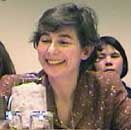 Much of UNESCO‘s work is directed to saving the planet for future generations. This can be achieved as much by a “bottom up” process – people working in their communities — as by a “top down” approach and direction from above. Teachers have a special responsibility. Children often learn about whales and dolphins, but not about the global environment. We see nature sentimentally as wilderness, but at the rate of urban spread, cities will be our more realistic environment in the future. (Cities like Phoenix are expanding at the rate of one acre per hour.)
Much of UNESCO‘s work is directed to saving the planet for future generations. This can be achieved as much by a “bottom up” process – people working in their communities — as by a “top down” approach and direction from above. Teachers have a special responsibility. Children often learn about whales and dolphins, but not about the global environment. We see nature sentimentally as wilderness, but at the rate of urban spread, cities will be our more realistic environment in the future. (Cities like Phoenix are expanding at the rate of one acre per hour.)
Cities, as they developed in the nineteenth century, are blamed for environmental degradation, poverty, and inequality. However, we should recognize the environmental value of cities as they are unique laboratories for sustainability. Their “ecological footprints” (see later student presentation) reveal the relationship between the consumption needs of cities and the area of cultivation that is required to supply them. The green spaces within cities perform necessary functions in protecting air and water quality, biodiversity, as well as providing recreation. Cities are centers of trade, political activity, and cultural diversity. They illustrate the interdependence of all aspects of the environment.
UNESCO has established a joint program with the Earth Institute at Columbia University to study cities as biosphere reserves. We can learn much by studying the logistics of how cities are economically sustainable and use and conserve their resources. Children need to know more about their immediate environment, the environmental degradation and poverty in cities, but also the resilience of cities and their social and cultural values. Environment is not only what happens in the wilderness, but every action and everyday decisions by ordinary people that can affect the rest of the world, especially in large urban areas. New York City is a good example.
Rio+10
Zehra Aydin-Sipos
Programme Officer, Division for Sustainable Development, Department of Economic and Social Affairs (DESA), United Nations
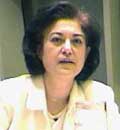 Ms. Aydin-Sipos spoke of the significance of the Summit Meeting on Sustainable Development in Johannesburg this coming September. It is not only a review of the 1992 meeting in Rio de Janeiro, but also a new beginning. Many people have worked to organize it in the last two years. It will include not only governments, but also representatives from civil society. Sustainable Development requires the participation of major groups which have a stake and interest in a viable future. It needs a multi-disciplinary approach with business, labor, and other organizations. The lessons of the last ten years have shown that a partnership with civil society which requires accountability and transparency from all organizations is more lasting and effective.
Ms. Aydin-Sipos spoke of the significance of the Summit Meeting on Sustainable Development in Johannesburg this coming September. It is not only a review of the 1992 meeting in Rio de Janeiro, but also a new beginning. Many people have worked to organize it in the last two years. It will include not only governments, but also representatives from civil society. Sustainable Development requires the participation of major groups which have a stake and interest in a viable future. It needs a multi-disciplinary approach with business, labor, and other organizations. The lessons of the last ten years have shown that a partnership with civil society which requires accountability and transparency from all organizations is more lasting and effective.
Many partners in this effort have developed “best practices” in dealing with problems of sustainable development. But the world is still full of problems, and what are best practices in some areas must become normal in all. The Johannesburg Summit is a partnership initiative to work with many stakeholders in a sustainable future. The participants are coming together in a series of Preparatory Committees (PrepComs) to identify what they can do together.
There are two challenges for education. First, people’s minds need to be changed. They need to learn how to think in an integrated way, how the choices they make today will affect society. Secondly, educators can become active partners in the summit initiative by checking the website for information and ideas (http://www.johannesburgsummit.org/ ), and by proposing their own curricula for teaching about sustainable development. Many educators are determined to put such curricula into use and become part of the process of working for a sustainable future.
Student Presenters and Teachers
Our Ecological Footprints
Ming Alterman and Ms. Carmela Federico
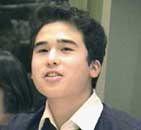 Ming Alterman, a very competent and well organized high school junior at Student, Friends Seminary, New York, NY, described the process he went through to calculate the “footprints” or “earth share” his family consumed. He plugged food, housing, utilities, goods, waste, health, and education costs into formulas that had been developed by the Sustainability Education Center. The formulas and explanations can be found at http://www.rprogress.org/ and the Sustainability Education Center website is http://www.sustainabilityed.org/ .
Ming Alterman, a very competent and well organized high school junior at Student, Friends Seminary, New York, NY, described the process he went through to calculate the “footprints” or “earth share” his family consumed. He plugged food, housing, utilities, goods, waste, health, and education costs into formulas that had been developed by the Sustainability Education Center. The formulas and explanations can be found at http://www.rprogress.org/ and the Sustainability Education Center website is http://www.sustainabilityed.org/ .
Ms. Frederico of the Sustainablity Education Center, The American Forum for Global Education, briefly described one indicator of sustainability, “biological footprints,” which is defined as the “space” taken (resources used by) an individual /town/nation. This ‘space’ can be calculated numerically and the results show dramatically how much more ‘space’ — the ‘sum’ of natural resources being used up — is taken up by a rich person compared with a poor one.
Bomba de Mecate
(Building Water Pumps in Nicaragua)
Doerte Dannemann
Student, and Mrs. Marika Heimbach, Teacher, Kooperative Gesamtschule (KGS), Rastede, Germany
Marika Heimbach and Doerte Dannemann
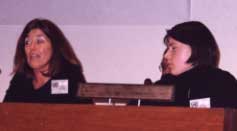
Ms. Dannemann and Mrs. Heimbach described an ongoing program with a school in Nicaragua. Nine KGS students who attended the CTAUN conference had spent time in Bomba de Mecate, installing a system of water pumps. The water level had receded and villagers needed to walk miles to reach clean water sources. The students displayed a series of posters showing how this project had been accomplished.
Teaching Sustainable Development
Carlos Calderon and Dr. Greg Julian
Student
Associate Professor, Environmental Studies, Pace University, Pleasantville, NY
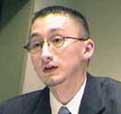
Carlos Calderon described a model UN program scheduled this May at Pace University. He is particularly interested in “empowering” youth and is working on a “youth proposal” for submission by youth at the Johannesburg Summit. He emphasized the importance of working WITH youth and the potential power of young people.
Keynote Speaker
Our Environmental Destiny
Mr. Robert F. Kennedy, Jr
Professor, Environmental Law and Co-Director of the Pace Environmental Litigation Clinic, Pace University School of Law, White Plains, NY
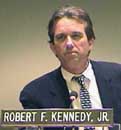 Robert Kennedy gave an impassioned speech about the crucial importance of the right laws being in place to protect the environment. It is never enough to leave it to the politicians and businessmen whose decision-making is often based only on short-term views.
Robert Kennedy gave an impassioned speech about the crucial importance of the right laws being in place to protect the environment. It is never enough to leave it to the politicians and businessmen whose decision-making is often based only on short-term views.
He gave a graphic account how of a small group of working fishermen from Crotonville on the Hudson River had realized that their livelihood was under great threat from pollution and they had to make a legal challenge to the business interests involved. After a great fight they finally prevailed in the courts.Mr. Kennedy explained that these citizens were proclaiming a long tradition of public ownership of the ‘the Commons’ which went back to Roman Law. Later this tradition had been reaffirmed in the Magna Carta and in the United States Bill of Rights.
He is currently working with an organization called ‘Riverkeepers’ which advocated peoples rights over the environment. Because of Riverkeepers’ success in cleaning up the Hudson River, its ideas are now being taken up with regard to other rivers in the U.S. and now even throughout the world.
He stressed that good environment policy is an essential part of good economic policy and that environmental degradation loads onto the next generation which will have to pay to put things right. A truly ‘free market’ policy has to support the aim of sustainable development and business should be expected to pay the costs of pollution and clean-up. The present generation has a moral responsibility to the next generation and to the poor who usually have to bear the brunt of environmental degradation.
Mr. Kennedy concluded that it is shared values and a common respect for the land — both for the local environment and for the nation’s wildernesses – which are the foundation stones of ‘community’. These are the pillars of our national well-being.
Closing Remarks
Mrs. Gillian Sorensen
Assistant Secretary-General for External Relations
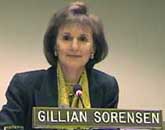 Mrs. Sorensen welcomed Mr. Kennedy to the United Nations and praised his dedication and focus on peoples’ rights to a sustainable environment, speaking poignantly of her family connections with his uncle and father. She especially noted her pleasure in participating with CTAUN and underlined the importance of this conference, its subjects, and presenters which highlighted the ongoing work of the U.N. Closing the conference, she urged us to keep learning and teaching about the United Nations.
Mrs. Sorensen welcomed Mr. Kennedy to the United Nations and praised his dedication and focus on peoples’ rights to a sustainable environment, speaking poignantly of her family connections with his uncle and father. She especially noted her pleasure in participating with CTAUN and underlined the importance of this conference, its subjects, and presenters which highlighted the ongoing work of the U.N. Closing the conference, she urged us to keep learning and teaching about the United Nations.
Photos from the conference

